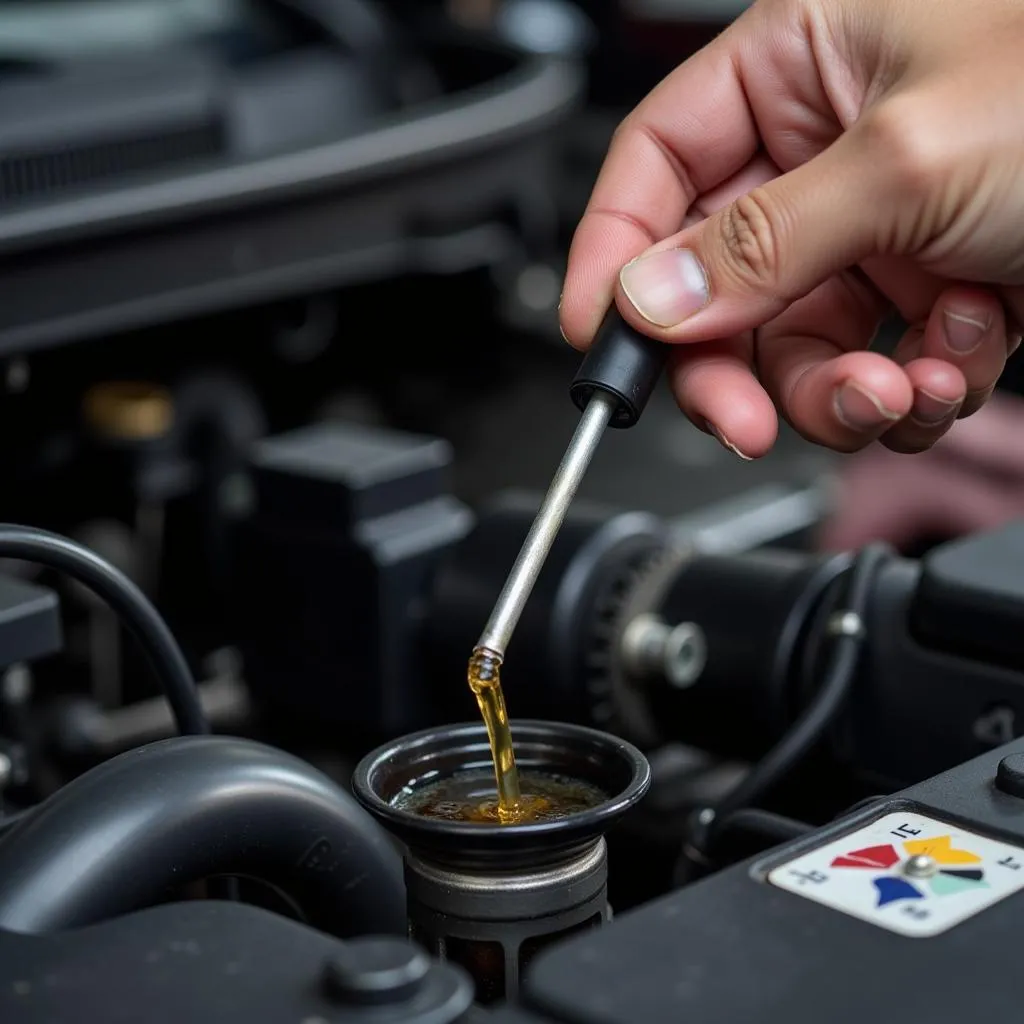Knowing how to check your car’s oil is a fundamental part of car ownership. Regularly checking your oil level and condition helps ensure your engine runs smoothly and can even prevent costly repairs down the line. This guide provides a clear, step-by-step approach to checking your car’s oil, empowering you to take control of your vehicle’s health.
Understanding the Importance of Oil
Think of engine oil as your car’s lifeblood. It lubricates moving parts, reduces friction, dissipates heat, and helps remove harmful contaminants. Without sufficient oil, your engine can overheat, wear down prematurely, and eventually fail.
Gathering the Necessary Tools
Before you begin, gather these simple tools:
- Clean Rags or Paper Towels: These are essential for wiping away excess oil and ensuring an accurate reading on the dipstick.
- Gloves (Optional): Wearing gloves will keep your hands clean during the process.
- Owner’s Manual: Refer to your owner’s manual for specific oil recommendations and instructions for your car model.
Step-by-Step Guide to Checking Your Car’s Oil
Follow these steps for an accurate oil level check:
- Park on a Level Surface: Parking on a flat surface ensures an accurate oil level reading.
- Turn Off the Engine: Allow your engine to cool down for a few minutes. This prevents burns and lets the oil settle back into the oil pan.
- Locate the Dipstick: Look for a brightly colored (usually yellow or orange) dipstick handle, typically located near the front of the engine.
- Remove and Wipe the Dipstick: Pull the dipstick out slowly and wipe it clean with a rag or paper towel.
- Reinsert the Dipstick: Carefully insert the dipstick all the way back into its tube.
- Remove and Check the Oil Level: Slowly pull the dipstick out again and examine the oil level.
- Two Marks: Most dipsticks have two marks indicating the acceptable oil level range – a minimum and a maximum mark. Ideally, the oil level should be between these two marks.
- “Add” and “Full” Marks: Some dipsticks may use “Add” and “Full” marks instead. The oil level should be closer to the “Full” mark.
- Add Oil If Necessary: If the oil level is below the minimum mark or “Add” mark, you’ll need to add oil. Refer to your owner’s manual for the recommended oil type and the location of the oil filler cap.
- Check Oil Condition: Observe the oil’s color and consistency.
- Clean Oil: Fresh oil typically has a light, amber color.
- Dark or Gritty Oil: Dark brown or black oil, or oil that feels gritty, may indicate it’s time for an oil change.
 Mechanic checking car oil dipstick
Mechanic checking car oil dipstick
How Often Should You Check Your Oil?
It’s a good practice to check your oil level at least once a month. Additionally, check your oil before and after long road trips, especially during hot weather conditions.
Common Oil-Related Issues
While checking your oil level, be aware of these potential issues:
- Low Oil Level: Low oil can be caused by oil leaks, burning oil within the engine, or infrequent oil changes. If you frequently need to add oil, have your car inspected for leaks.
- Overfilled Oil: Adding too much oil can be just as harmful as having too little. Overfilling can lead to increased engine pressure, oil leaks, and potential damage to engine components.
- Milky Oil: If the oil on the dipstick appears milky or frothy, it may indicate coolant is mixing with the oil – a sign of a potentially serious engine problem that requires immediate attention.
 Mechanic performing car engine oil change
Mechanic performing car engine oil change
The Role of Dealer Scanners
While visually inspecting your oil is crucial, modern vehicles often provide more detailed insights through the use of dealer scanners. These advanced diagnostic tools can access your car’s computer system and provide information on:
- Oil Life Percentage: Many cars now have an oil life monitor that calculates the remaining life of your oil based on driving conditions and mileage.
- Oil Pressure: Dealer scanners can display real-time oil pressure readings, which are essential for understanding the efficiency of your engine’s oil pump.
DiagXcar: Your Trusted Resource for Dealer Scanner Information
Understanding your car’s oil health is vital, and dealer scanners provide a comprehensive way to monitor its condition. For in-depth information and reviews of the latest dealer scanners, visit DiagXcar. We’re committed to equipping you with the knowledge and tools you need to keep your car running smoothly.
Frequently Asked Questions (FAQs)
1. What happens if I don’t check my oil regularly?
Neglecting regular oil checks can lead to insufficient lubrication, increased engine wear and tear, overheating, and ultimately, engine failure, which can be a costly repair.
2. Can I check the oil level immediately after turning off the engine?
It’s best to wait a few minutes after turning off the engine to allow the oil to drain back into the oil pan for an accurate reading.
3. What does it mean if my oil light comes on?
If your oil light illuminates while driving, it typically indicates low oil pressure, a serious issue that requires immediate attention.
4. How often should I change my car’s oil?
Oil change intervals vary depending on your car model, driving habits, and the type of oil used. Refer to your owner’s manual for specific recommendations.
5. Where can I find a reliable mechanic to change my oil?
Ask for recommendations from friends, family, or check online reviews for reputable mechanics in your area.
Need Assistance? Contact Us!
For any questions or assistance related to car maintenance and diagnostics, reach out to our team of experts via WhatsApp: +1(641)206-8880, Email: [email protected] or visit us at: 276 Reock St, City of Orange, NJ 07050, United States. We’re available 24/7 to assist you.


